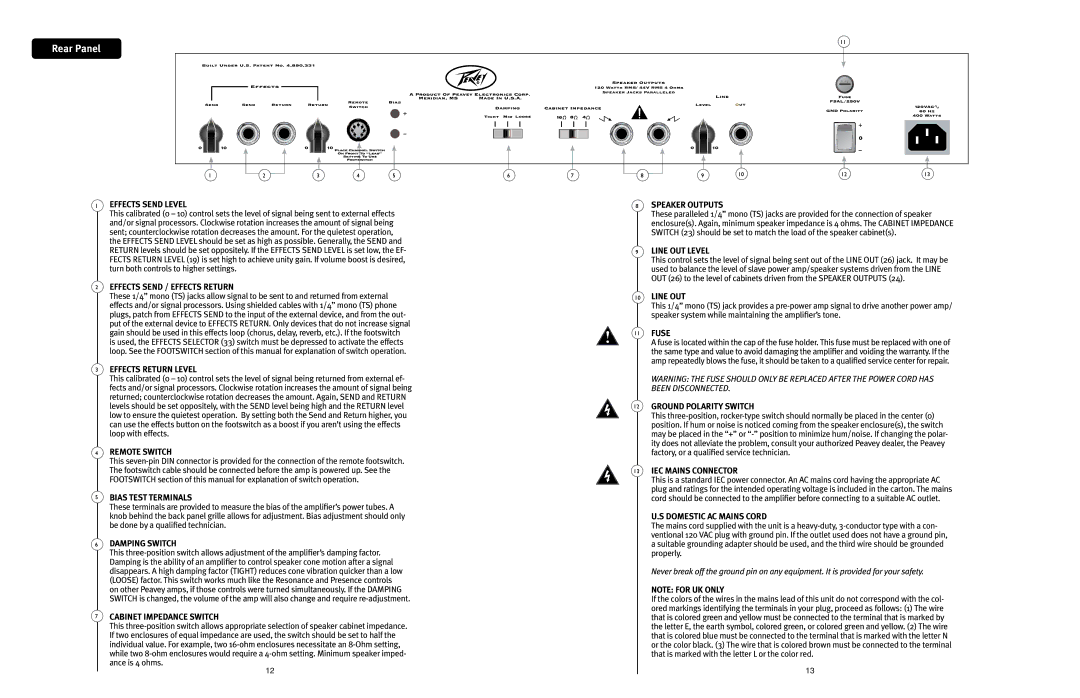
Rear Panel
|
|
|
|
|
|
|
|
|
| 11 |
|
1 | 2 | 3 | 4 | 5 | 6 | 7 | 8 | 9 | 10 | 12 | 13 |
1EFFECTS SEND LEVEL
This calibrated (0 – 10) control sets the level of signal being sent to external effects and/or signal processors. Clockwise rotation increases the amount of signal being sent; counterclockwise rotation decreases the amount. For the quietest operation, the EFFECTS SEND LEVEL should be set as high as possible. Generally, the SEND and
RETURN levels should be set oppositely. If the EFFECTS SEND LEVEL is set low, the EF- FECTS RETURN LEVEL (19) is set high to achieve unity gain. If volume boost is desired, turn both controls to higher settings. ![]()
2EFFECTS SEND / EFFECTS RETURN
These 1/4” mono (TS) jacks allow signal to be sent to and returned from external effects and/or signal processors. Using shielded cables with 1/4” mono (TS) phone plugs, patch from EFFECTS SEND to the input of the external device, and from the out- put of the external device to EFFECTS RETURN. Only devices that do not increase signal gain should be used in this effects loop (chorus, delay, reverb, etc.). If the footswitch is used, the EFFECTS SELECTOR (33) switch must be depressed to activate the effects loop. See the FOOTSWITCH section of this manual for explanation of switch operation.
3EFFECTS RETURN LEVEL
This calibrated (0 – 10) control sets the level of signal being returned from external ef- fects and/or signal processors. Clockwise rotation increases the amount of signal being returned; counterclockwise rotation decreases the amount. Again, SEND and RETURN levels should be set oppositely, with the SEND level being high and the RETURN level low to ensure the quietest operation. By setting both the Send and Return higher, you can use the effects button on the footswitch as a boost if you aren’t using the effects loop with effects.
4REMOTE SWITCH
This
5BIAS TEST TERMINALS
These terminals are provided to measure the bias of the amplifier’s power tubes. A knob behind the back panel grille allows for adjustment. Bias adjustment should only be done by a qualified technician.
6DAMPING SWITCH
This
7CABINET IMPEDANCE SWITCH
This
12
8SPEAKER OUTPUTS
These paralleled 1/4” mono (TS) jacks are provided for the connection of speaker enclosure(s). Again, minimum speaker impedance is 4 ohms. The CABINET IMPEDANCE SWITCH (23) should be set to match the load of the speaker cabinet(s).
9LINE OUT LEVEL
This control sets the level of signal being sent out of the LINE OUT (26) jack. It may be used to balance the level of slave power amp/speaker systems driven from the LINE OUT (26) to the level of cabinets driven from the SPEAKER OUTPUTS (24).
10LINE OUT
This 1/4” mono (TS) jack provides a
11FUSE
A fuse is located within the cap of the fuse holder. This fuse must be replaced with one of the same type and value to avoid damaging the amplifier and voiding the warranty. If the amp repeatedly blows the fuse, it should be taken to a qualified service center for repair.
WARNING: THE FUSE SHOULD ONLY BE REPLACED AFTER THE POWER CORD HAS BEEN DISCONNECTED.
12GROUND POLARITY SWITCH
This
13IEC MAINS CONNECTOR
This is a standard IEC power connector. An AC mains cord having the appropriate AC plug and ratings for the intended operating voltage is included in the carton. The mains cord should be connected to the amplifier before connecting to a suitable AC outlet.
U.S DOMESTIC AC MAINS CORD
The mains cord supplied with the unit is a
Never break off the ground pin on any equipment. It is provided for your safety.
NOTE: FOR UK ONLY
If the colors of the wires in the mains lead of this unit do not correspond with the col- ored markings identifying the terminals in your plug, proceed as follows: (1) The wire that is colored green and yellow must be connected to the terminal that is marked by the letter E, the earth symbol, colored green, or colored green and yellow. (2) The wire that is colored blue must be connected to the terminal that is marked with the letter N or the color black. (3) The wire that is colored brown must be connected to the terminal that is marked with the letter L or the color red.
13
